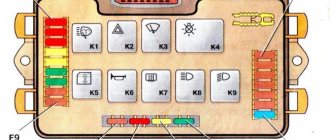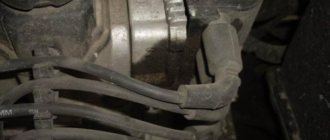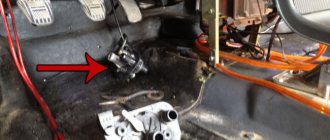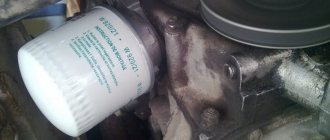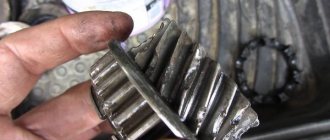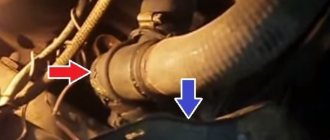The appearance of an antifreeze leak in the cooling system of a VAZ 2107 is a serious enough problem to pay attention to it and immediately begin to fix it. Leaking coolant can cause overheating and even engine failure.
The VAZ 2107 has many places susceptible to antifreeze leaks:
- Cooling radiator;
- Pipes and their connections;
- Water pump or water pump;
- Heater tap;
- Heater;
- Cylinder head gasket.
For each of the above places there are different ways to fix the problem. Naturally, the simplest method is to replace the damaged element. This applies to all possible problems, unless antifreeze is leaking at the connection points of the pipes. In this case, replacement will most likely not be required; just tighten the clamp.
Clear downgrade problems
This is not entirely relevant to our question, but it’s worth mentioning. This needs to be checked first, and if you have not identified the reasons, then we will dig deeper. So, antifreeze may leak due to a leak in the system, let’s look at it point by point:
- Engine radiator leaked . Of course, this can be determined very quickly, just look at it and also look at the stains under the car; if it is leaky, there will be red, green or blue drops. Of course, you can try to solder or clamp the radiator tubes, but often the plastic component (sidewalls) is damaged, there is nothing you can do about it, you need to replace it.
- Heater radiator . Almost the same picture, only the interior heater is leaking, it is more difficult to diagnose, because the coolant will drip onto the seal (carpet) in the cabin. But the reasons for the determination are simple: if there is a smell of antifreeze in the cabin (sweet smell), but not outside. If the glass sweats even in dry weather, and there is an oily coating on the glass. Liquid leaving the tank means your heater radiator is covered, of course, if you remove the plastic (decorative) protection of the instrument panel, you will see that it is dripping somewhere. We do the same, either restore it, or if this is impossible, change it.
- Hoses . They wear out over time, because they expand each time (when the engine heats up) and contract (when it cools down), such work will sooner or later damage them, they will not be able to hold pressure and will rupture. Of course, there may be minimal damage, but it will leak constantly. It is useless to make hoses; it is better to replace them.
- Tubes _ The situation is the same as with hoses, they are metal and usually last a long time. But there are situations when they also occur.
- Thermostat and pump . These are two mechanisms that are designed to pump and regulate the flow of coolant; the housings are made of metal or plastic and they often leak, this happens from time to time. For replacement, they are practically not repaired.
- The cap of the expansion tank and the tank itself. The cap is a valve , after a certain mileage it also fails, if it does not hold pressure, then antifreeze from the expansion tank can splash out when warming up. The tank itself may also burst, because it is made of plastic; if the lid is faulty, it may rupture. For replacement.
These are obvious reasons, they are worth checking first - ALWAYS! It often happens that the driver searches and cannot find it, but antifreeze (antifreeze) goes into, say, the stove and then into the passenger compartment, which is quite difficult to immediately determine. Park the car in a dry area or in a garage, if possible, and observe, if there are stains the color of your coolant, then this is definitely a leak, look for it!
Hidden problems
You have looked at everything and everyone, there are no leaks anywhere, all the hoses and clamps are in order, but the antifreeze or antifreeze goes away, “even if you crack”! The fact is that there are not only open leaks, but also so-called hidden ones, and they are much more dangerous.
A car engine is not a cast structure - there is a separate engine block and cylinder head. There is a gasket between these two parts, this is mandatory, it is high-temperature (can maintain high positive values), and it is also a sealing link. In the engine block, as well as in the cylinder head, there are channels through which antifreeze (antifreeze) passes, cooling the metal, thus the “entire engine” is at an operating temperature that does not exceed 90 - 100 degrees Celsius, without this fluid the engine would very quickly warmed up and it simply jammed.
So, the coolant also passes through the gasket, since it is an intermediate link (by the way, it has special channels). If the gasket is defective or poorly tightened, the tightness of the channels is broken and coolant can pass into the engine cylinders. That is, it will enter the combustion chamber, then through this chamber it will exit into the exhaust pipe, while the level of antifreeze (antifreeze) will decrease in the expansion tank.
What are the signs of such a breakdown?
- This is white and thick smoke from the exhaust pipe, it will really be like fog - we read about it here .
- The engine oil level will rise.
- The oil will be interspersed with antifreeze or antifreeze, that is, with bubbles.
- Coolant will leak out of the reservoir, and constantly.
In this case, it is 100% a gasket; we must change it. After all, sometimes antifreeze or antifreeze can get into the engine oil, and this is serious! Here the capital is just a stone's throw away.
- The oil mixes with the liquid and forms an incomprehensible “slurry”; it will begin to coagulate, which will clog all the channels - overheating of the engine is guaranteed.
- It will not be able to properly lubricate the engine cylinders, this will lead to wear of the piston rings.
- Also, this substance will clog all the channels on the crankshaft, which will also increase its wear; the liners in which it rotates can simply turn.
Bottom line - if antifreeze or antifreeze goes into the engine, driving is prohibited!
This is reason number “1”, however, antifreeze can also flow through various channels of the cooling system. They also have gaskets adjacent to the engine block and when they wear out they leak.
Why does liquid leave if it is not leaking anywhere?
The loss of fluid from the system may be hidden. It is not immediately possible to determine the cause, since smudges are nowhere to be seen. Antifreeze can even escape through a microcrack formed on one of the system components, since the leaking compound simply evaporates when the engine is heated and no traces of leakage can be detected. The worst thing is if the coolant goes into the crankcase and mixes with the oil, and this leads to a reduction in the life of the crankshaft and camshaft bearings, even with the slightest ingress. You can determine if antifreeze has gotten into the oil by simply removing the oil dipstick from a cooled engine and droplets of water will be visible on it, and the oil itself will be very dark. Antifreeze can leak even through a damaged or poorly pressed head gasket.
Coolant can also escape through a leaky bridge of the block gasket, entering the cylinder
In this case, you should pay attention to the color of the exhaust - it will be bluish or white. The gurgling of exhaust gases in the expansion tank cannot be ruled out.
In other cases, determining a coolant leak is quite difficult; it is best to contact a car service center.
At home, you can diagnose the system for leaks using pressure testing. The method is quite effective and simple. The essence of pressure testing is to pump pressure into the system using a conventional pump, which makes it possible to detect leaks at all points in the system where leaks have formed. By pressure testing it is possible to detect a leak in the manifold gasket, since it is impossible to detect a leak with a normal inspection - the coolant quickly evaporates when the engine is running.
Pressure testing of the car cooling system
Pressure testing of the system is carried out both in an auto repair shop and in a garage. At an auto repair center, the cost of work varies from 500 to 1 thousand rubles. Do-it-yourself crimping in your garage is quite simple, but you need to make a neck plug through which air will flow into the system. To make the neck you will need:
- tire valve;
- unnecessary radiator cap;
- drill.
The valve, or pipka in common parlance, is cut out of the old chamber along the contour of the circle, observing the diameter of the standard radiator cap gasket. A hole equal to the diameter of the pipe is drilled in the radiator plug.
After drilling a hole, it is necessary to process it with a round file to remove metal burrs
Having screwed the manufactured plug onto the neck, connect the pump to the valve and supply two pumps to the system, pressing the expansion tank plug with the palm of your hand. And it is also possible to supply air through the expansion tank.
The discharge pressure on the pressure gauge should not exceed 1 kg per square centimeter to avoid damage to the radiators
Pressure testing (pressure in the system) lasts about 2 minutes, after which all possible points of the cooling system are inspected for leaks. It is not recommended to use untested sealants and other chemicals added to the coolant to eliminate leaks, as this can cause irreparable damage to the entire cooling system, and these are completely different issues and a lot of money.
Troubleshooting
We will analyze the hidden defect when it is necessary to change the engine gasket. You cannot delay this, despite the apparent complexity of the process - almost anyone can repeat it.
- We purchase a gasket for your engine, make no mistake, this is important! It is advisable to select by VIN CODE
- Why do we remove the cylinder head cover, usually there are 8 to 12 bolts. Most likely, you will need to remove all sorts of pipes and other “air filters” attached to the top above it so that they do not interfere.
- Afterwards we need to unscrew the block head itself, here you will need to try, as a rule, they tighten the bolts tightly, if one of them unscrews easily - then most likely it’s the problem, it was simply not tightened at the factory! It is quite possible that after stretching the antifreeze will stop leaving the system! So first try tightening all the bolts.
- If that doesn't help, remove the head. As a rule, the leak will be immediately visible, it is either a crack or drips. I would also like to note that the gasket is disposable; you cannot do it by unscrewing the head once, for various reasons, and then putting it on the old gasket. The whole point is that it wears out - so you only need to install a new one.
- After replacement, we assemble everything in reverse order. It is necessary to pay special attention to the tightening of the cylinder head; it is done in a checkerboard pattern, with a certain force, which is adjusted with a torque wrench.
Personally, I myself have fixed this breakdown a couple of times on our VAZs and GAZELLES. Antifreeze or antifreeze will stop leaving.
Wow, I wrote a lot, but these are almost all the reasons why a leak can occur. Of course, the block itself may burst, that is, it will drive out from under the metal, but this happens extremely rarely, I think 1 in 10,000 cars, and maybe less often.
If someone doesn’t understand something, watch the video version of the article.
This is where I end, I think it was useful.
(
20 votes, average: 4.10 out of 5)
Similar news
Evaporation of antifreeze and other causes of its leakage. Let's take the fur off.
Is it possible to mix antifreezes? Various colors and manufacturers.
How to check the cap (plug) of the expansion tank? Instructions.
The situation when antifreeze leaves the expansion tank is familiar to many car enthusiasts. In some cases, the cause of the breakdown can be determined with the naked eye. A cracked tank, serious leaks under the bottom of the car will not leave it unnoticed. But a number of breakdowns are hardly possible to determine without qualified assistance. In such cases, the coolant gradually leaves the tank, the owner does not find any defects and simply tops it up.
Natural causes
When a car owner discovers a leak and carefully checks the entire system for damage, the absence of major problems with the radiator, hoses, tubes and barrel may seem like a good sign. But this is not entirely true, because antifreeze is involved in many processes, and the integrity of the main elements may indicate more serious problems with the engine. But before you go to a service station, it is worth taking into account the natural factors of why antifreeze may decrease from the system:
ATTENTION! A completely simple way to reduce fuel consumption has been found! Don't believe me? An auto mechanic with 15 years of experience also didn’t believe it until he tried it. And now he saves 35,000 rubles a year on gasoline! Read more"
- Time factor. It is impossible to achieve perfect tightness of the system. In addition, temperature changes in different areas lead to the gradual evaporation of antifreeze. For each car model, depending on operating conditions, there are established consumption standards.
- Seasonal factor. Most complaints from owners about a sharp decrease in antifreeze levels come in the winter. Antifreeze consumption increases for understandable physical reasons. Negative temperatures cause the liquid to contract in volume, and the reverse process occurs when the engine is running. A decrease in level in such cases is normal and there should be no cause for concern.
It is important to understand that natural causes of low coolant levels result in very slow flow rates. If a car enthusiast in winter has to occasionally add a small amount of antifreeze to the keg, then there is nothing wrong with that.
Radiator repair methods
- You can try to clean a clogged radiator using high-pressure running water. A special product that is poured inside for several hours will help remove scale and other deposits.
- If there are leaks in a copper radiator, it is better to contact an experienced solder. Perhaps he will be able to repair the crack or hole.
- Fixing a crack in an aluminum radiator is quite difficult. In this case, it will be easier to replace the heat exchanger.
- It is not advisable to use mustard or similar industrial products to seal the radiator. Having eliminated one breakdown (leak), there is a high probability of getting another (clogging).
Read also: Pioneer radio speakers
Obvious damage
Antifreeze is designed to cool a car engine. A liquid with many additives is used in warm and cold seasons. Most compounds allow you to operate the machine at temperatures below - 60 degrees. A complete lack of coolant in the system will lead to rapid overheating of the engine, it will jam, and the car will fail. It is very expensive to overhaul the most expensive element in a car, so you need to carefully monitor the technical condition of all elements . The most common breakdowns that can lead to a rapid noticeable loss of antifreeze levels are:
- Damage to the main radiator. In this case, it is extremely difficult not to notice the leak, since smudges will form under the car. If you look under the bottom, you can find blue, green or red droplets. Most often, a radiator fails due to mechanical damage to thin tubes called honeycombs. In most cases, the culprit is stones that can fly out at high speed from under the wheels of other cars. Older cars that have been in use for more than 10 years may experience rust on the radiator tubes. In this case, they literally fall apart due to corrosion. The reasons for the destruction of the side plastic radiator tanks are similar.
- Failure of the heater radiator. The rate of leakage from the cooling system is approximately the same as when the main radiator is damaged, but diagnosing the failure is much more difficult. Very often, owners do not understand where the antifreeze goes if it does not leak anywhere. It is likely that the problem lies in mechanical damage to the heater radiator, and antifreeze drips onto the seal in the cabin. In this case, experienced car enthusiasts advise paying attention to the characteristic smell in the cabin and strong fogging of the windows in any weather. To finally verify the correctness of the diagnosis, it is necessary to disassemble the dashboard. If it is difficult to do such work yourself, you can contact a service center.
- Problems with the expansion tank or cap are the most common failure, so when there is a coolant leak, you should pay attention to these elements of the system first. It is not difficult to diagnose a breakdown if the seal of the lid is broken or there is a crack in the upper part of the barrel. In this case, the antifreeze will seep out and splash other elements under the hood. But if there is mechanical damage in the lower part of the barrel, it is extremely difficult to find out the cause of the liquid leak. Most car models will require complete removal of the element. If no damage is detected, then there is no need to rush to replace components. First of all, you need to check the bypass valve, which is built into the plug. Very often it becomes clogged, which leads to leakage.
- The connecting hoses inside the system are constantly subject to expansion due to exposure to high temperatures and subsequent restoration to their original dimensions. During the cold season, they can significantly shrink in size.
- Problems with tubes. Despite the fact that the connecting tubes are made of metal and usually last a very long time, they also fail due to mechanical damage. Most often the reason for this is the time factor. Corrosion can spread quite quickly, and it is not easy to notice the presence of a defect in time. Liquid can leak out very quickly through cracks in metal.
- Thermostat or pump defects. These two mechanisms in the car are designed to pump and regulate the flow of coolant. Depending on the car model and year of manufacture, the body of the parts can be made of metal or plastic. It is rarely possible to repair damaged elements, so most often it is recommended to replace important parts.
- Pump leaking. If during diagnostics it was possible to notice that a puddle of antifreeze forms at the place where the water pump is located, then in most cases the cause of the leak is the pump. But it is extremely difficult to accurately track the location of the leak, since modern car models are equipped with all kinds of casings, boots, seals, underbody protection and other elements that can accumulate draining antifreeze. The pump itself is a very durable and solid product, so most often a leak appears due to problems with the seal or gasket, which is located between the pump flange and the cylinder block. Additional difficulties await owners of front-wheel drive cars, since the pump is usually located under the timing cover.
How to change a stove radiator to stop antifreeze leaking?
- You can drain the antifreeze from the engine block, but this procedure is not necessary, because the losses will be small.
- Two clamps from the engine compartment are unscrewed from the radiator pipes, and the hoses are pulled together.
- The fasteners of the rubber seal are unscrewed and removed.
- Next, remove the radio panel in the cabin.
- The drive cable fastener is unscrewed and disconnected from the heater tap using a key set to “7”.
- Using a screwdriver, remove the four spring clips on the fan casing.
- We lower the casing itself down, moving it to the left. The wires will completely prevent you from removing it.
- Now you can remove the heater radiator from the casing.
The stove tap, metal pipes and the radiator itself must be carefully inspected. The tubes should not show signs of corrosion or leakage of coolant. The stove tap must be replaced if its handle does not open or close or if traces of antifreeze leakage are visible.
If you are replacing a stove radiator, and the tubes and tap are still in good condition, then they can be installed on a new radiator. Just don’t forget about the new gaskets, which need to be lubricated with silicone sealant. The outlet pipe and valve are screwed to the radiator quite tightly, but be careful with the effort, otherwise you can strip the threads or crush the gasket. Silicone sealant is also useful for lubricating the radiator tube when rubber hoses for antifreeze supply are connected to them.
Difficulties in diagnosis
Despite the fact that all such reasons are obvious, it is not always possible to independently determine where the antifreeze goes from the expansion tank. For example, very often damage to pipes remains invisible to the naked eye. In such cases, experienced car enthusiasts advise letting the engine cool completely, dry your hands thoroughly and carefully feel each connecting element. Microcracks will definitely make themselves felt , and coolant leaks will form on the hose.
The situation is more complicated with defects in clamps. The tricky part is that the liquid will accumulate in large drops at the joints, then fall on the heated surface and instantly evaporate. The characteristic smell of antifreeze will help you notice the presence of a problem. It can be felt when the hood is open or in the cabin. If the leak occurs due to a loose connection in a hard-to-reach place, then, most likely, you will have to carefully study the condition of the system in the pit.
Another nuance is related to the protective elements under the bottom of the car. For example, the cause of a leak may be a malfunction with the gaskets installed in the pump. But the drops will fall on the protective casing, and antifreeze stains will form in the area under the radiator. In this case, you can search for a long time for the true cause of the breakdown.
The best advice in this case is to remove the protective casing and carefully examine the condition of all the main components of the cooling system.
Signs of a coolant leak
The main and most obvious sign of a malfunction in the cooling system is a puddle of antifreeze under the engine compartment where the car is parked. This can be either a full-fledged puddle, consisting of all the antifreeze that was in the cooling system, or a few drops, which also does not bode well for the car enthusiast.
In the first case, the cause is most likely a ruptured pipe or radiator. It's quite easy to notice, just open the hood and look closely.
In the second case, the reason lies in a cracked pipe, a microcrack in the radiator, a poor connection of pipes, or a faulty gasket. Then it is much more difficult to diagnose where the antifreeze is leaking, and often only professional auto mechanics can do this quickly.
In addition, another sign of a coolant leak is a persistent smell of antifreeze in the cabin: it indicates a malfunction with the heater. Often the smell is accompanied by wet rugs, in which case it is necessary to begin troubleshooting immediately. Antifreeze vapors are toxic to the body and can cause severe poisoning if inhaled.
An elevated engine temperature may indicate either an ineffective cooling system or a low level of antifreeze resulting from a leak. It is worth knowing that most modern cars have a coolant level sensor, and when the antifreeze level is critical, a special indicator lights up on the dashboard.
Hidden leaks
Car owners often complain that antifreeze is running out, but the reasons cannot be determined, because all connecting tubes and hoses are in good condition. It is also not possible to detect leaks under the bottom, there is no characteristic smell in the cabin, but the coolant level has to be constantly replenished. In this case, this may mean that the reason lies in hidden leaks, which even experienced professional mechanics cannot quickly detect. The most common hidden leaks:
- Gasket defect. A car engine is not a monolithic structure; it consists of a large number of elements. But all the main parts are protected by a special design, so special grooves have been created to allow antifreeze to flow inside. Violation of tightness, partial destruction of the gasket due to a temporary factor can lead to coolant entering the cylinders. This means that antifreeze penetrates the combustion chamber and exits through the exhaust pipe. It is very difficult to definitively confirm the breakdown on your own, since disassembling the engine without the necessary experience is not recommended. But you can pay attention to the main signs: thick white smoke from the exhaust pipe, rising oil levels.
- Malfunction of the expansion tank cap, which is associated with jamming in the open position. In this case, the pressure in the system is disrupted, and the antifreeze evaporates very slowly through the hole. The problem is especially acute when the engine is running intensively, because without a normal level of pressure, antifreeze boils at a lower temperature and evaporates from the system very quickly. In this case, it is impossible to detect traces of leakage. A malfunctioning thermostat can make the situation even worse. An important element does not direct liquid to the main radiator; the coolant circulates in a very small circle, boils and literally squeezes steam through the cap. Such a process can lead to a critical increase in engine temperature.
If coolant leaves the expansion tank, then urgent measures must be taken to determine the cause. Some defects require immediate response.
For example, engine gasket problems can cause serious deterioration in oil quality. Because of this, the cylinders are poorly lubricated, and therefore the piston rings wear out. All these factors can lead to overheating of the motor, in which case major repairs will be necessary.
Head gasket
This is the most unpleasant of malfunctions, as a result of which antifreeze leaks from the system. If there is a breakdown on the outside of the gasket, the leak can be seen with the naked eye on the engine. It's worse if the gasket is broken near the cylinder. In this case, the defect can be determined by indirect signs - an increase in the oil level in the oil pan, a large amount of water vapor from the exhaust pipe. Regardless of the location of the damage, the identified defect can only be eliminated by replacing the gasket.
In any of the above cases, one of the signs of a malfunction is a decrease in the coolant level. Having discovered this, you should immediately start looking for the cause. Timely diagnosis and troubleshooting will help avoid serious troubles with your car.
The first step is to find out where the leak is coming from.
The reasons why coolant leaks can be divided into 3 general groups:
- Leaks in mating parts, damage;
- Low-quality materials and parts (of which there are quite a lot on the domestic market);
- Installation work was carried out incorrectly;
Leaks in mating parts and damage to seals:
With damage, in principle, everything is quite simple - these are cracks in the pipes, fittings to which these pipes are connected, destruction of the sealing gaskets. It also happens that the clamp that secures the pipe rubs the rubber in it with its corrugated inner surface, or the pipe itself is already reaching the end of its life. The pump seal may also be leaking. In any case, it is better to replace damaged parts.
As for leaks, it is worth noting the following: in order to avoid leakage through the seals, it is necessary that the planes of the parts being connected are even and smooth. The plane should not be humpbacked and have depressions and “slides”. The pipe fittings should also be smooth and clean. The tightening of such connections should be moderate. If you overtighten, you can get a “hump” in the planes and antifreeze will leak. In the case of pipes, you can get “wrinkling” of this pipe and also leakage of antifreeze. If you don't hold it up, it will be leaky. If the leak is relatively small, you can slightly tighten the connections (planes, pipes), but if the leak does not stop, it is worth checking that the conditions listed above are met.
Troubleshooting methods
Auto repair technicians can quickly and accurately determine where the coolant goes. But sometimes the car owner simply has nowhere to go and needs to fix the breakdown on his own. In some cases this is possible:
- The pipes need replacing. If the breakdown makes itself felt on the road, the liquid can leave the system very quickly, so you can temporarily fix the crack with adhesive tape or tape.
- A crack in the expansion tank can be sealed. But this is another temporary measure that will prevent antifreeze from running at high speed.
- A stuck lid valve can be cleaned, this will help return the proper fluid level to the system. If cleaning does not produce results, then it is worth replacing the part with a new one.
Problems with the pump and radiator are very difficult to fix on your own. In rare cases, repair of important elements of the system is possible, but most often it is necessary to replace parts.
Many drivers face such a problem as a refrigerant leak. This thing is not only expensive, but also dangerous for the engine. Therefore, if you notice that the liquid level in the tank is rapidly decreasing, that is, antifreeze is leaving, it is necessary to urgently take appropriate measures. What could be the reasons for this phenomenon and how to correct the situation, we will consider in this article.
Preventing engine breakdown
In order to avoid engine breakdown due to loss of coolant, it is necessary to periodically check all system components for potential leaks. Of course, you should definitely monitor the refrigerant level in the tank. When the engine is running, it should never be below the MIN mark. Signs that antifreeze is running out may include the following factors:
- The stove doesn't work.
- The fluid level in the reservoir periodically drops.
- The engine overheats or its temperature does not rise to operating temperature.
Heater valve
Typically, a sign that the faucet is leaking is the appearance of a puddle of antifreeze on the carpet under the passenger’s feet. It is absolutely not advisable to repair this part, so we simply buy a new faucet and replace it. There is no need to drain all the antifreeze, so after installing a new tap, simply add as much coolant as leaked during operation.
Checking the integrity of cooling system components
In the event of a leak, the system must be inspected in the following sequence:
- Check the expansion tank housing for cracks.
- Inspect the engine radiator.
- Check the heater core.
- Inspect the thermostat housing.
- Check all connections of the pump and cylinder block. In addition, you should inspect the pump drain hole. If leakage is detected, this means that the oil seal has worn out.
Possible problems with the radiator
The reason that antifreeze leaves the expansion tank is the depressurization of the cooling system components. Most often, problems arise with the radiator. Damage to this structural element can occur as a result of external physical impact (for example, when punctured by a stone). The plates, which are constantly damaged by the ethylene glycol contained in antifreeze, may also be worn out. Some radiators may be equipped with plastic tanks. The latter should also be checked in case of loss of antifreeze. Over time, the plastic begins to crack.
Checking the Thermostat
If the antifreeze leaves, the reasons may be a depressurization of the thermostat. It also needs to be carefully checked for leaks. Usually the reason is the gaskets. In addition, the engine may overheat due to a malfunction of this element. It is not difficult to determine how correctly a given node works.
The circulation of liquid in the small and large circles is checked by touch - by the temperature of the hose and pipes. In a working cooling system, the thermostat valve is closed until the antifreeze temperature reaches a certain value (in LADA Priora - up to 90 degrees). In this case, antifreeze circulates in a small circle. Therefore, both the radiator itself and the hose below are colder than the thermostat housing. When the antifreeze heats up to 90 degrees, the valve begins to open slowly, and a flow of hot liquid enters the radiator. As a result, the latter gradually heats up. The valve will open completely at a temperature of 102°C. In this case, all the antifreeze will begin to pass through the radiator. The upper part will feel hotter than the lower part.
The engine must be left running until the radiator fan operates. In this case, it is necessary to monitor the arrow of the temperature indicator. After it approaches the border of the red zone, the fan should turn on. When the liquid cools down, it turns off.
Hose rupture and pipe damage
Antifreeze can also leak through a damaged hose or through a depressurized pipe. This is especially often the reason why antifreeze runs out in older cars. The fact is that the hose material begins to age and crack over time. It can easily burst due to liquid pressure. The fastening at the connection also weakens over time. Therefore, in order to avoid troubles, hoses in domestic cars should be changed at least once every 5 years, and in foreign cars - once every 10 years. For fastening, you should use screw clamps rather than tape clamps, since they are much more reliable.
You can determine that the hoses are to blame for the leak by inspecting the floor for antifreeze stains. Sometimes the damage may not be too serious and invisible to the eye. In order to detect such a small leak, you must first thoroughly wipe the hose, and then rev it up a little and turn off the engine. Next, a careful inspection is carried out. The problem of coolant loss can worsen during the cold season. The fact is that the lower the temperature, the lower its viscosity. That's why antifreeze disappears faster in winter.
How to properly drain antifreeze
Of course, before you start replacing the cooling system elements that have become unusable, you need to drain the antifreeze. They do this as follows:
- First of all, be sure to turn off the engine and let it cool. If this is not done, when you open the lid, antifreeze vapor will escape under pressure and you will get burned.
- After the engine has cooled, open the locking cap of the tank.
- Remove the lower lining of the compartment.
- You will need to place a wide tray under the engine to receive antifreeze.
- Remove the lower water radiator hose.
In a four-cylinder engine, you need to remove the thick hose on the left side, as well as the thin one leading to the heating system. After this you can start draining. In a six-cylinder engine, the screw plug is unscrewed from the bottom of the block.
Under no circumstances should antifreeze be poured down the drain. The liquid is very toxic. Therefore, it should be poured into a separate container and disposed of.
Thus, if antifreeze is lost, it is necessary to thoroughly check all components and parts of the cooling system for leaks. Elements that have become unusable should be replaced immediately. Over time, such problems can lead to the need for expensive engine repairs, and in some cases they can even be dangerous to health.
Replacing the coolant: why is this event being carried out?
The cooling system of modern cars is presented in the form of a liquid-type system, which means heat is removed from the car engine through liquid. The coolant circulates through the system, removing heat from the engine and cooling in the radiator. The pump or water pump redirects the cooled portion of the liquid to the engine to cool the latter again. The heat exchange process occurs continuously while the car engine is running and the pump is rotating.
As the coolant is constantly exposed to different temperatures, it loses its properties over time. When antifreeze loses its properties, its boiling point decreases and approaches the boiling point of ordinary water. Most often this happens after a mileage not exceeding 60 thousand km. It is at this mileage that it is recommended to completely replace the antifreeze in order to avoid unforeseen and undesirable consequences. Before we begin the replacement, let’s find out how to properly drain antifreeze from a VAZ 2107.
How to properly drain used fluid
To drain antifreeze from a VAZ 2107 car, simply opening the tap is not enough, through which all the liquid will flow out of the system. Both antifreeze and antifreeze are toxic substances, so when working with them you should follow safety rules. Before draining, it is necessary to prepare a container into which the waste will be drained. The volume of such a container should not be less than 10 liters. The best option for such purposes is a trough or basin.

